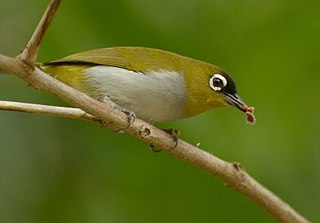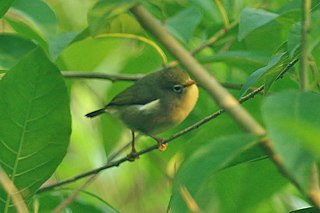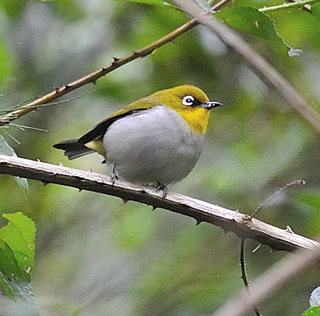
Zosterops is a genus of passerine birds containing the typical white-eyes in the white-eye family Zosteropidae. The genus has the largest number of species in the white-eye family. They occur in the Afrotropical, Indomalayan, and Australasian realms. Typical white-eyes have a length of between 8 and 15 cm. Their most characteristic feature is a conspicuous white feather ring around the eye, though some species lack it. The species in this group vary in the structural adaptations of the tongue. The Zosterops [griseotinctus] group is an example of a "great speciator" inhabiting a vast area and showing a remarkable morphological differentiation on islands, some of which maybe as close as 2 km (1.2 mi) apart.

Pamela Cecile Rasmussen is an American ornithologist and expert on Asian birds. She was formerly a research associate at the Smithsonian Institution in Washington, D.C., and is based at the Michigan State University. She is associated with other major centers of research in the United States and the United Kingdom.

The warbling white-eye, also known as the Japanese white-eye and mountain white-eye, is a small passerine bird in the white-eye family. The specific epithet is occasionally written japonica, but this is incorrect due to the gender of the genus. Its native range includes much of East Asia, including the Russian Far East, Japan, Indonesia, Korea, and the Philippines. It has been intentionally introduced to other parts of the world as a pet and as pest control, with mixed results. As one of the native species of the Japanese islands, it has been depicted in Japanese art on numerous occasions, and historically was kept as a cage bird.

The black-fronted wood quail is a bird species in the family Odontophoridae, the New World quail. It is found in Colombia and Venezuela.

The white-fronted tit is a species of bird in the family Paridae. It is endemic to the Philippines found in the islands of Luzon and Mindanao. Its natural habitat is tropical moist lowland forests. It is threatened by habitat loss.
Sanford's white-eye is a species of bird in the family Zosteropidae. It is endemic to Nendo Island.

The black-crowned white-eye is a songbird species. It is closely related to the Old World babblers, and its family Zosteropidae might better be included in the Tiimalidae. Its subspecies from the Sulawesi region might warrant recognition as distinct species Z. subatrifrons. The Sangihe white-eye and the Seram white-eye were formerly included in Z. atrifrons, as is still, on occasion, the black-fronted white-eye.

The lemon-bellied white-eye is a species of bird in the family Zosteropidae. It is endemic to Indonesia, where it occurs on a number of islands from the Sunda Strait to the Aru Islands. It is present on several of the Lesser Sunda Islands as well as on parts of Sulawesi, as well as many smaller islands, but is absent from the larger islands of Borneo, Java, Sumatra and Timor. Currently, HBW describes five sub-species of lemon-bellied white-eye. However, the extensive distribution of Z. c. intermedius is likely to contain more than one reproductively isolated population (cf. Z.c. intermedius and Z. c. flavissimus, with the latter now considered a distinct species, the Wakatobi white-eye.

The bridled white-eye is a species of white-eye native to the Mariana Islands and formerly Guam. The species' natural habitat is subtropical or tropical moist lowland forests.

The São Tomé white-eye is a species of bird in the family Zosteropidae. It is endemic to the island of São Tomé, where it occurs in the central massif and in the southwest. Its natural habitat is mid- to high-altitude forests. It is threatened by habitat loss. It was named by the Italian Tommaso Salvadori in 1901.

The Malagasy white-eye is a species of bird in the white-eye family, Zosteropidae. Found in Madagascar and Seychelles, its natural habitats are subtropical or tropical dry forests, subtropical or tropical moist lowland forests, subtropical or tropical mangrove forests, and subtropical or tropical moist montane forests.

The green-fronted white-eye is a songbird species. It is closely related to the Old World babblers, and its family Zosteropidae might better be included in the Tiimalidae. Some sources include this species within Z. atrifrons, the black-crowned white-eye. The black-fronted white-eye was formerly considered a subspecies, and until it was split as a distinct species, the name "black-fronted white-eye" was also used for Z. minor.

The Christmas white-eye is a species of bird in the family Zosteropidae. It is endemic to Christmas Island. Its natural habitats are tropical and subtropical moist broadleaf forests and subtropical or tropical moist shrubland. It is threatened by habitat destruction.

Heuglin's white-eye, also known as the Ethiopian white-eye, is a species of bird in the family Zosteropidae. It is found in north-eastern and eastern Africa, primarily in Ethiopia and Kenya. Its natural habitats range from subtropical or tropical moist montane forests, to subtropical or tropical high-altitude shrubland, plantations, and rural gardens.

The Rota white-eye or Rota bridled white-eye is a species of bird in the family Zosteropidae. It is endemic to Northern Mariana Islands.
The Seram white-eye is a small passerine bird in the white-eye family. It is an endemic resident breeder in open woodland in Seram, Indonesia.

The Togian white-eye is a species of bird in the family Zosteropidae.

Adolph Nehrkorn was a German ornithologist and collector of bird eggs.

















